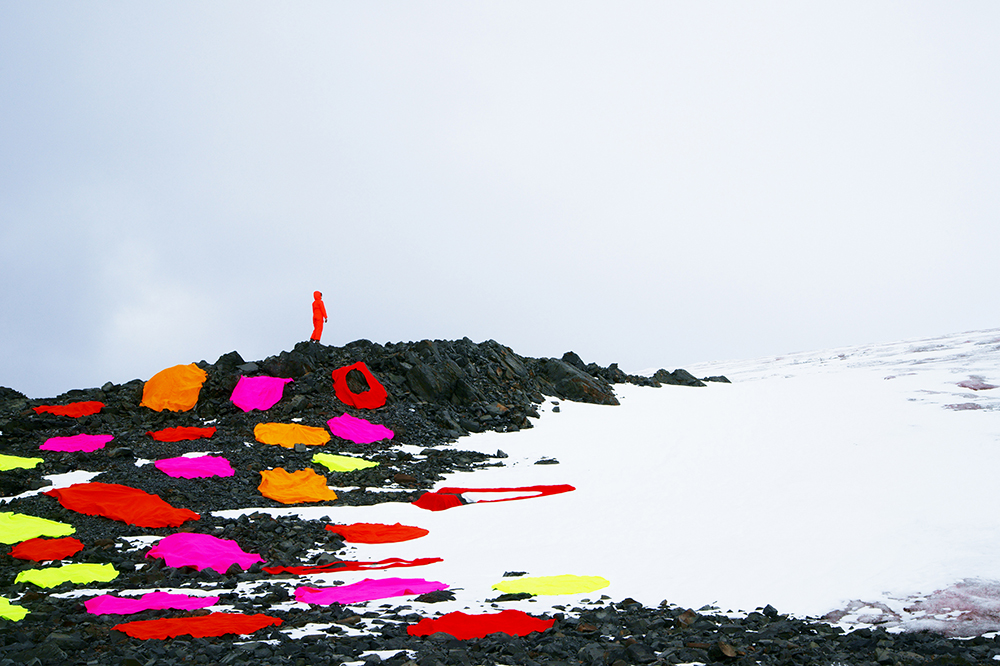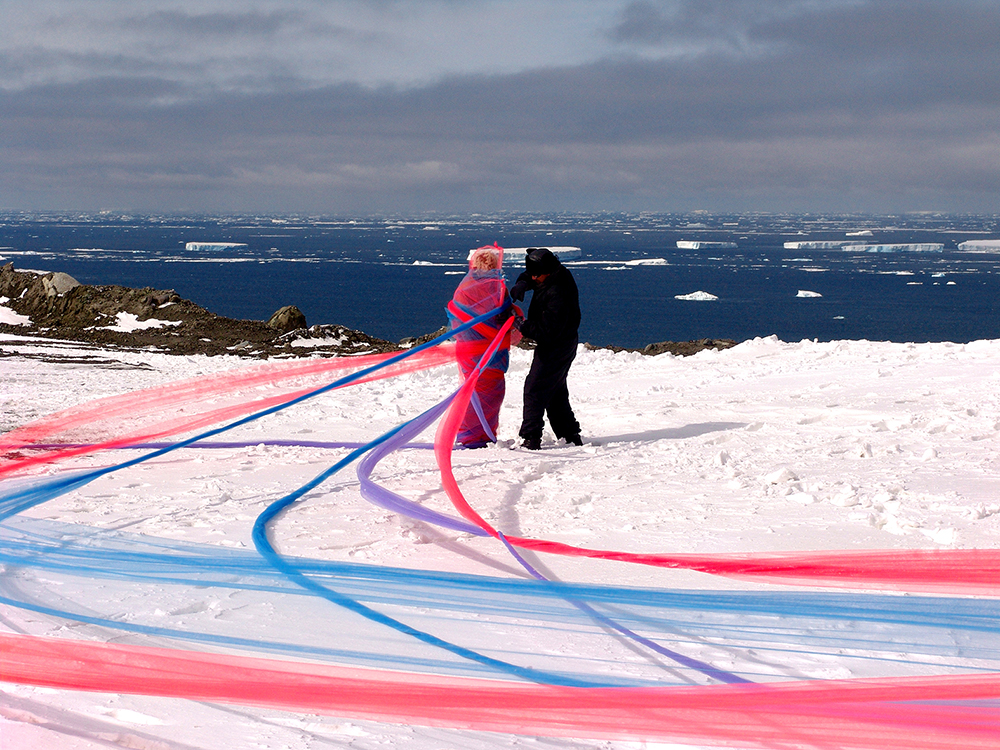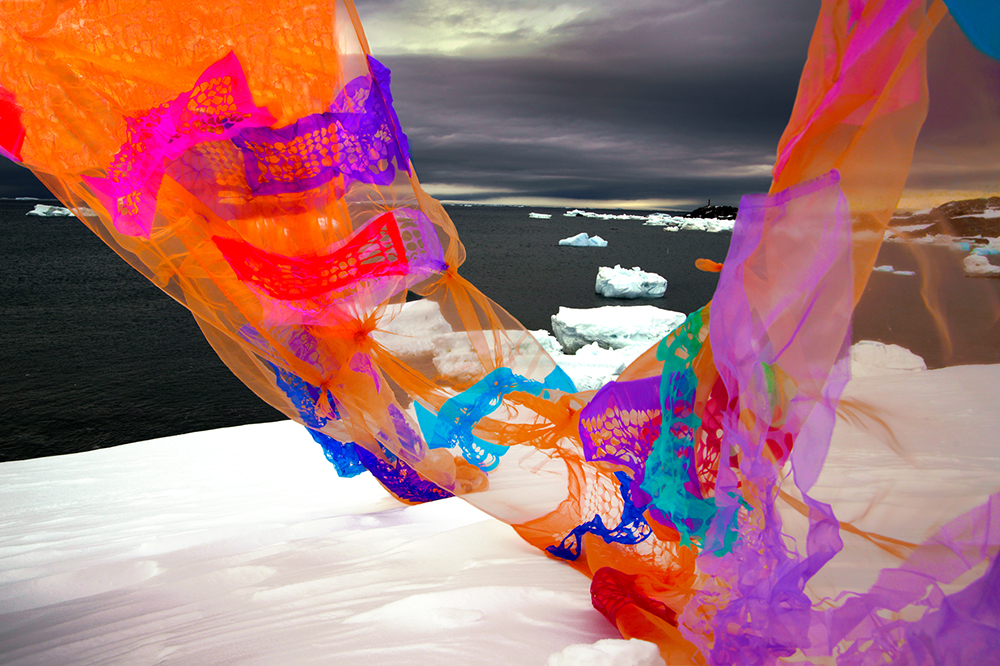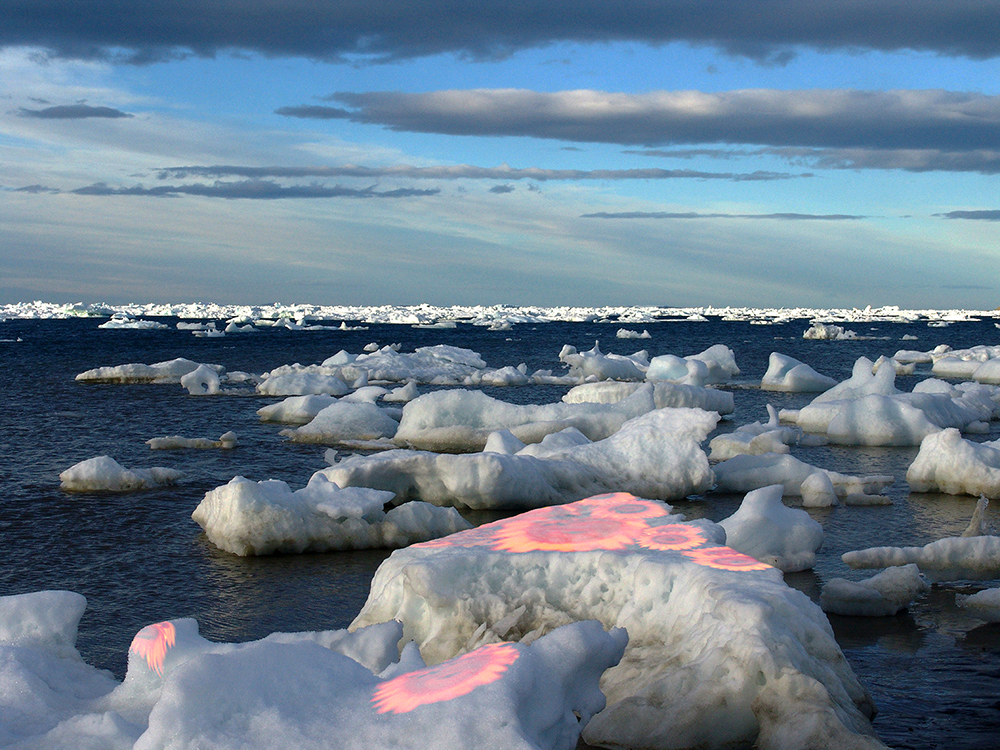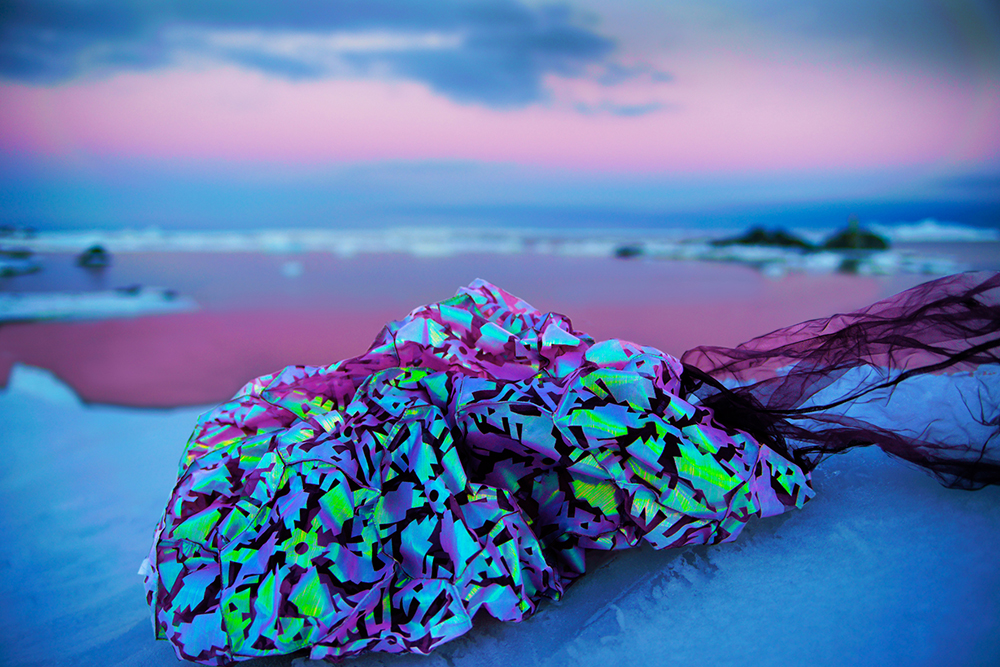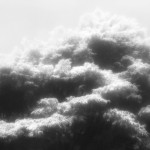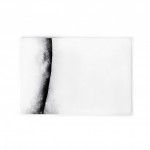América Latina Week: Andrea Juan
This interview was written with the kind help of and in conjunction with Elena Gálvez Mancilla – Mexican historian and sociologist; a researcher on the Amazon and indigenous culture, interested in the image as a historical source, photography enthusiast and environmental activist. The post is featured in both English and Spanish. The Spanish version follows the English.
I have great admiration for Andrea, what an inspiration she’s become for a whole generation of artists. Not only is she a well-respected photographer, but she is also the creator of many projects that have aided artists’ development; from Sur Polar, an artist residency in the Antarctic, to Arte en el Origen, a project that starts with prehistoric art and results in creation and consciousness in nature.
She cares; about the Earth, water and habitats. But overall, she cares about treating oneself and others with respect. With these images, she has sought to awaken our innate capacity to care. Her documentation, performance and artistic process include a 10-year research period in the Antarctic. Over the years, she has studied scientific research on the continent in order to make the invisible and inaccessible, poetically visible.
Andrea Juan was born in 1964 in Buenos Aires, Argentina and she is based in Cantabria, Spain from 2014.
Visual artist and curator, she works with photography, digital video, graphic art, objects and installations. Graduated in Visual Art, she worked in printmaking in her early professional career, achieving her first distinctions and awards. From 1996 she researched with non-toxic printmaking, using mixed techniques.
In 1999 she started to work outside the studio. She travelled to Austria, Germany and the U.K., where she developed projects related to human being condition, using photo and video. Since 2002 she has definitively developed all her artwork outdoor, in the environment working exclusively on natural scenarios. From 2005 to 2014 she carried out performances and video installations in Antarctica based on scientific research related to climate change. She generated sites specific and installations using projections, fabrics and objects that registered in photography and video.
She received several awards and distinctions including Guggenheim Foundation Fellowship, New York., US; UNESCO – ASCHBERG grant, France; Canadian Research Program, Montreal, Canada; Unit of Research in Visual Arts – University of Quebec, Canada; Art Omi International Artist in Residence, New York, US and Argentinean Funds of Arts Award. Among the prices are Gold Amazon Award, Benin; United Nations Award from Tallinn Triennial, Estonia; the International Art Biennial of Beijing Award, China, Konex award 2002 and 2012; Antorchas Foundation Award and Critic Association Award from Argentina, among others.
She has been invited to participate in Biennials, such as Casablanca, Morocco; Beijing, China; La Habana, Cuba; Rotterdam, The Netherlands; The End of the World, Ushuaia; Expo Yeosu, Korea and Expo Shangai, China.
Andrea has performed solo shows in Antarctica, Auckland, Bangkok, Barcelona, Beijing, Berlin, Bilbao, Brisbane, Bristol, Buenos Aires, Canberra, Casablanca, Córdoba, Christchurch, Denver, Cairo, Guayaquil, Guadalajara, Houston, Kiel, La Habana, London, Los Angeles, Melbourne, México DF, Miami, Montreal, Moscow, New York, Perm, Quebec, Rio de Janeiro, Rotterdam, Sao Paulo, Saint Petersburg, Santa Fe, Santander, Santiago de Chile, Seoul, Seville, Shanghai, Sidney, Sofia, Tokyo, Toronto, Turin, Ushuaia, Venice,Vienna, Washington, Yeosu and Xalapa.
@smproart
Antarctica Project (2005 – 2014)
This project is based on researches on the impact of climate change and was supported with the Guggenheim Fellowship. These studies address the consequences of receding glaciers, loss of mass of the Antarctic ice, the disappearance of Larsen ice shelf, the release into the atmosphere of methane gas (greenhouse) and other aspects that increase the atmospheric and ocean temperatures caused by global warming.
I based my work on the research carried out by different scientists, I immersed myself in their Papers, giving life to the different Series of the project. In my works I use poetry and beauty through saturated and bright colors, to be able to dialogue and reflect with the viewer about our environment.
Antarctica Project comprises different Series of Site Specific and Performance artworks, recorded in SOOC Photo and video, developed between 2005 and 2014 in different bases and locations in Antarctica.
In Red, in 2005, the performer unfurled eighty meters of red tulle on snow and ice, in the Esperanza Bay. The action carried out on the glacier refers to the disintegration and disappearance of the Larsen I and II ice shelves, where tons of drinking water melt into the ocean, raising the sea level and modifying the marine ecosystem.
I developed Projections in 2005 too, where I projected two videos: “Sunflower” and “Encapsulated” onto different landscapes, glaciers and icebergs. The Series is based on research on climate change. I had previously filmed the videos in London and in sunflower fields in the Province of Buenos Aires.
I performed Methane series in 2006 and 2007, and based my work on the study that reflects on the fact that under the ice there are large deposits of methane gas that move to the surface during the loss of the ice masses which had kept them in place, resulting in the environmental changes taking place on the peninsula. I used tulle in different colors in the performances as a metaphor of the gas.
I created Geo Radar Series in the austral summer of 2008. It is based on the study of the composition of Antarctic soils investigating the feasibility for the installation of wind turbines in Antarctica to obtain clean energy. I worked with acrylic rigid rods in different opacities and colors.
Invisible Forest is a Series of works I made in 2010. The project is based on scientific studies on weather modification produced by marine phytoplankton, known by researchers as “The Invisible Forest”. I carried out the performances and actions with human mannequins made of fabric and replicas to macroscopic size scale of marine flora I made with felt.
New Species is a Site Specific I developed in 2011. I based it on the New Species that were found in the Weddell Sea, in Antarctica, after the disappearance of the Larsen ice shelves I and II, that was produced by the warming of the oceans. I made the objects in felt and wool with metal structures.
The following year, in 2012, I developed the New Eden Series. On the volcanic surface of those soils, I found fossils of tree trunks, remains of seashells, tusks and fossilized bones of animals, relics of the past in Antarctica, when it belonged to Gondwana and was a forest. A New Eden may unfold again in these frozen lands in the distant future. The performances and actions I did with various large fabrics and weaves, which partially covered the surface.
Organic was a Site Specific Project I carried out in 2013. It is related to the evolution and multiplication of the “New Species” found in the Weddell Sea. I made the objects with different kind of fabrics, such as acrylics; PET molded elements; Rubber transfers on tulle; nylon, spandex, polyester, silk, crepe de chine, chantu silk, synthetic fabrics and organza.
And the last series was Solar Storm, developed in 2014. I based this series on scientific research in relation to solar radiation. During a solar storm, millions of tons of plasma with the strongest radiation is expelled, throughout the Solar System and thus reaches us, almost imperceptibly, almost invisibly. I worked with balls and metallic, fluorescent and translucent fabrics.
Creating art in this environment was deeply exciting and it was extraordinary to experience with those new colors and that unimaginable brilliance. However, it required the need to be prepared to face unexpected extreme weather and the encounter of being alone in a pristine, deserted space. This reflection on the environment aims to show viewers the complete project that has been carried out for more than 10 years.
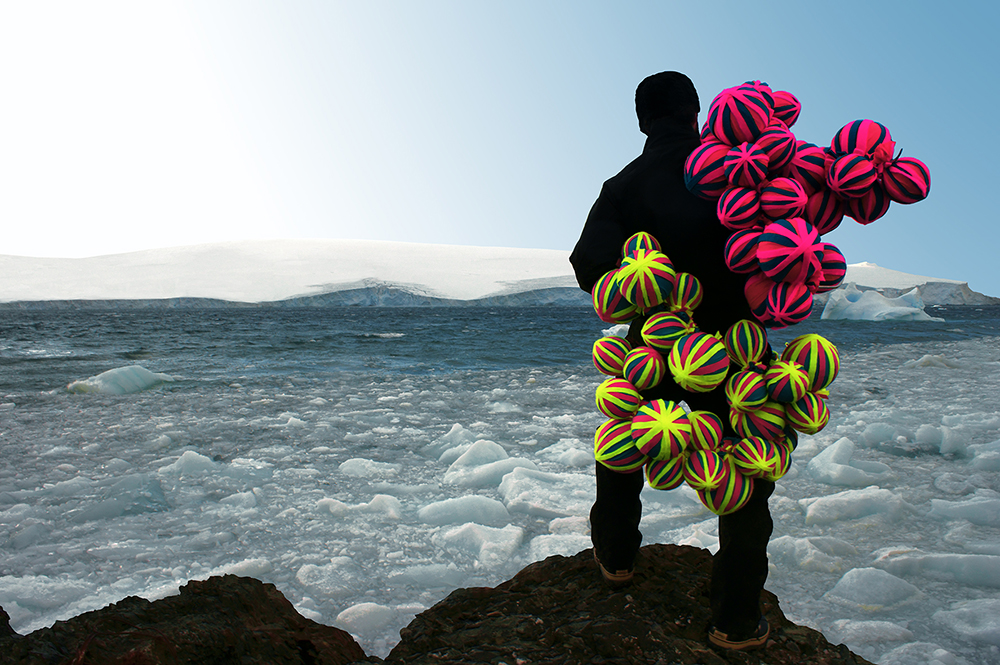
©Andrea Juan, New Species
Only a year ago, there was a huge exhibit in the Peabody Essex Museum that showed the last 300 years of art and the environment. It is a relevant contemporary topic. Do you believe that art can save the world? Why do you do photographs of the environment? Have you noticed any public or institutional changes regarding climate change after featuring your books and shows?
Art can have a dialogue about one’s worries with people, with spectators. Where there is dialogue, there is the possibility of change and the modification of certain behaviours that could make the world a better place. The artist’s vision is somehow multiplied in the spectator through this process. After so many years of Sur Polar and so many exhibitions, the consequence has been a moved and affected public. I believe that people know what is happening around them, humanity’s current circumstances. However, they regarded the issue of climate change and scientific information from a different perspective because it touched their hearts…
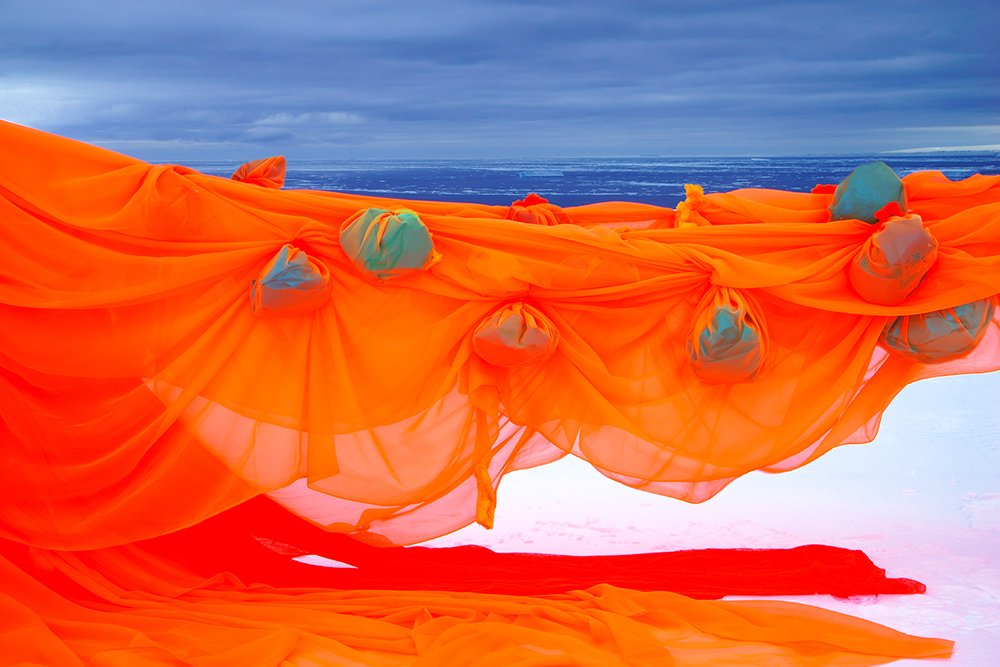
©Andrea Juan, Solar Storm
The environment’s current state can be quite hard to explain. Despite the evidence, we’re living in a time in which we all no longer follow the same facts. This topic has come to be beyond description. How have you worked with science?
It all started little by little. My first working relation with science happened in the Argentinian Patagonia, where I started working around the impact on glaciers by climate change. Later on, with the possibility that I have had of travelling to the Antarctic, I got to meet many scientists who were developing their work year after year in this cold continent. That is how I got a hold of scientific research and began inquiring in glaciology, biochemistry, biology and other various areas in order to comprehend their work. They shared their projects and research, openly; it was a new world for me, to have such direct access to this information. These scientific papers are usually written in technical terms that are usually more complicated for people in general, they are written for other scientists and academics. So, I also had the opportunity to ask about the language that was being used and clear out all my queries.
It was an amazing experience, we shared leisure time too and that is how we spoke about how their work was developing and understand it in detail. It was quite beautiful to observe how they saw their work transformed poetically. Their research was seen, with more general and fluent access than the one that academic language allows; observed by a larger amount of people.
I know that you were a Visual Arts student and that an important part of your process is performance arts. Why did you choose photography?
I studied in the School of Fine Arts and specialized in painting and engraving. I worked a lot with etching, aquatint and later on with non-toxic graphic materials. Photography and video were added to further develop photogravure and continue working on graphics. With the use of digital cameras, came the possibility of cutting and overlapping images on different layers. To me, it was very similar to working with engraving. Soon enough, I was dedicated to working with photography and video exclusively.
When thinking about how photography might be useful, we perceive its capacity of encapsulating a bit of evidence from reality. I believe that when we discuss climate change and people who deny it, photography becomes an enabler of reflective thought. I would like to know more about the work behind your photographs. Could you speak about the process and materials that you use?
In order to travel to the Antarctic one must be capable of managing one’s own luggage, to be able to carry everything oneself. Thus, my working equipment had to be light, waterproof and big enough to be noticed in such a huge space (these are locations where there is no human-sized reference). Being in a scientific and military base meant that there was no possibility of acquiring materials upon arrival, everything I needed had to be taken there from the continent. I took textiles and (in 2005) a high-resolution projector to project videos and images on glaciers. Year after year I added more textures, colours and materials. For Solar Storm, namely, I took very large quantities of fabric that I had prepared for that series specifically.
Elena: Your dialogue with science allows the abstraction of certain elements; glaciers, fossils, phytoplankton, etc. Which the non-specialized people do not have access to.
We have a popular consciousness about the Antarctic, with images such as the ones with melting glaciers. However, you introduce elements which we cannot see and cannot understand from the outside. How do you represent that which is invisible through these abstract forms?
It is really about sharing, through poetry, certain scientific projects. As with the phytoplankton project that you mention, I saw these minuscule particles under a microscope and fell in love. These are tiny particles that balance out our planet. Through metaphors, I was able to make them visible on a much wider scale. I worked with my own elements and depicted them in space and on the landscape. The materials that I use have to be visible and powerful, they need volume and the capacity for the absorption of light; that is why I liked to use felt in many different colours.
Yazmeen: Are some of these depictions real phytoplankton under the microscope?
They are digitally modified. They are real phytoplankton images under the microscopes, but I add them one by one over a blue background until I create the interweaving that is the final photograph.
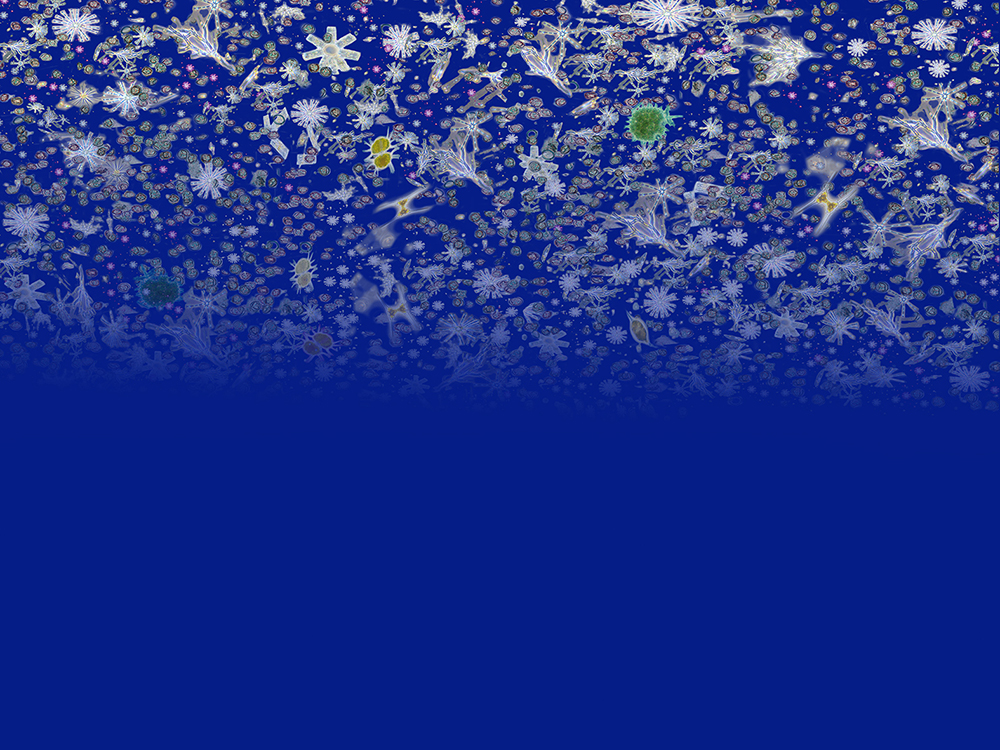
©Andrea Juan, Invisible Forests
Many of your photographs show the immersion of colour in space. In others, like Invisible Forest, there is the use of mannequins in space. What is humanity’s role in this series?
Invisible Forest is a representation of humans, but stripped humans. In previous years, I worked with other people as performers but they always wore a lot of clothes because of the cold. Sometimes, so many layers take away the fluidity of the character. I cannot go to the Antarctic with a huge group of people in order to stage a performance; but I can take rigid, fabric mannequins of around 1,20m. The silver lining was that they were never cold and could stay still over ice, with a thermal sensation of -45 degrees Celsius, for long periods of time.
The mannequins’ colour allows them to be immersed in space, they look like they belong.
Yes, they are the site’s inhabitants.
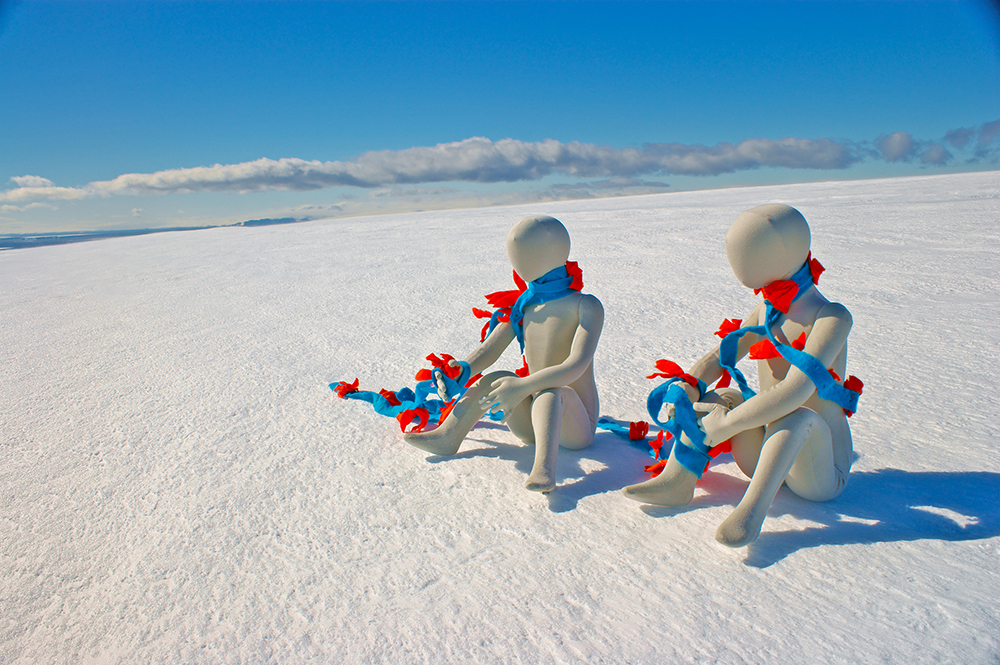
©Andrea Juan, Invisible Forests
Elena: The dialogue between science and art spectators is interesting because at the same time there is an international movement/lobby for climate change denial and they invest a lot in the propagation of their discourse. How do you think that your work is able to discuss with this political issue regarding climate change?
That is a complicated question. This project does not have a political, climate change backdrop, I think it has a wider scope. It has to do with taking care of others, respect, caring for our home and our habitat. It does not have to do solely with climate change, that is just an aspect of it. I have made climate change visible so that it is concrete, but in reality, it has to do with how we live everyday life and the care of the spaces we inhabit. If we destroy it, we’ll be dead soon. More than politics and climate change denial, I worry about our actions for/with others.
Elena: To that effect, one might say that your work’s vision is aligned to an individual spectator and what that may cause.
Yes, I believe that the individual adds up and becomes social. I truly believe that action originates from what we’re able to modify on the inside.
What is your most impressive and unforgettable memory from the Antarctic?What did that 10 year experience teach you?¿Qué es lo más interesante o impresionante sobre trabajar en la Antártida? ¿Qué te enseñó aquella experiencia de 10 años?
It has taught me so many things… Mainly, to work in a site that is not related to anything I knew before; from its geography to functionality. People who are in the Antarctic work there, they are not visiting with tourist expectations… There is a relevant difference when visiting the base, everyone is concerned exclusively on the work they are doing. Work is present at all times, the job lasts the time you are there. There are no businesses, sidewalks, malls… Everything is so different. Water needs to be made, all waste materials are taken back to the continent, a whole year’s food produce arrives by boat once a year and if you need something extra you might be able to ask for it before small planes plan to depart from the continent. However, if there is no possibility of attaining what you need, well that’s just reality and you have to use what you have… It has a lot to do with what I told you before, taking care of the space where you live in is important. Taking care of our water, food and waste is a way of living. It is a real lifestyle and an important lesson. Also, to know that we are tiny and that nature is in command. We ought to be respectful.
¿What projects are you working on for the near future? I know that you are living in Cantabria and that you have an ongoing exhibition in the Altamira Museum that analyses art techniques and the environment.
The most beautiful phase of moving to Cantabria was the reencounter with the love of my life, Gabriel. We now work and live together, in fact, we developed the piece in Altamira together. ¡Quién! is an ongoing installation, assembled in 2018, in the Altamira National Museum and Research Centre. It reflects on who we are, it creates a relationship with the spectator through different mirror fragments. In the end, the piece allows to see oneself, full-body, through the object’s reflective surface. It is us as humans, our own evolutionary species, who created the pieces on the Altamira caves – one often forgets that.
Currently, we are renovating our house in Northern Spain. It will become our studio and future arts residency. We’re also working on Arte en el Origen, seminars that start with talks on art in prehistoric times and culminate in the development of art pieces, by the artists, in different natural environments.
We also created a video installation for the Casablanca Biennial in Morocco, Forgotten Words, on those words that are not on the US constitution. Referring to the lack of environmental rights and legislature on the constitution.
Now, we are preparing for another project that will be assembled in February, in Bordeaux, France. It’s called Respeto and really, it has to do with everything we have been talking about…
ESPAÑOL
Esta entrevista se hizo con la amable ayuda de Elena Gálvez Mancilla. Historiadora y socióloga mexicana, estudiosa de la Amazonia y la historia indígena, interesada por la imagen como fuente histórica, amante de la fotografía y activista ecologista.
Tengo mucha admiración por Andrea, se ha vuelto una gran inspiración para toda una generación de artistas. Además de ser muy reconocida por su trabajo fotográfico, ha creado oportunidades de desarrollo artístico; desde Sur Polar hasta Arte en el Origen.
Su trabajo muestra su preocupación sobre el planeta, el agua, el medio ambiente; pero sobre todo, se preocupa sobre el respeto para con nosotrxs mismxs y lxs demás. Sus fotografías despiertan nuestra capacidad innata del cuidado por y para el otrx.
Su trabajo documental y performático incluye un proceso investigativo de 10 años en la Antártida. Durante este período, estudió la investigación científica llevada a cabo en el continente con el fin de hacer que lo invisible e inaccesible, sea poéticamente visible.
Andrea nació en 1964 en Buenos Aires, Argentina y, actualmente vive y trabaja en Cantabria, España, desde el 2014.
Artista visual y comisaria, ella trabaja con fotografía, video digital, arte gráfico, objetos e instalaciones.
Graduada en Artes Visuales, ella se especializó en grabado al inicio de su carrera recibiendo sus primeras distinciones y premios. Desde 1996 investigó en grabado no tóxico usando técnicas mixtas.
En 1999 comenzó su trabajo fuera del estudio. Andrea viajó a Austria, Alemania y el Reino Unido donde desarrolló proyectos relacionados a la condición humana usando fotos y vídeos. Desde 2002 ella ha definitivamente desarrollado toda su obra en el exterior, en el medio ambiente trabajando exclusivamente en escenarios naturales
De 2005 a 2014 realizó performances y videoinstalaciones en la Antártida basadas en investigaciones científicas relacionadas con el cambio climático. Ella generó instalaciones de sitio específico utilizando proyecciones, tejidos y objetos que registraron en fotografía y video.
Recibió varios premios y distinciones, incluida la Beca de la Fundación Guggenheim, Nueva York, EE. UU.; Beca UNESCO – ASCHBERG, Francia; Programa de Investigación Canadiense, Montreal, Canadá; Unidad de Investigación en Artes Visuales – Universidad de Quebec, Canadá; Art Omi Artista Internacional Residente, Premio Fondos de Arte de Nueva York, Estados Unidos y Argentina. Entre los precios se encuentran Gold Amazon Award, Benin; Premio de las Naciones Unidas de la Trienal de Tallin, Estonia; el Premio de la Bienal Internacional de Arte de Beijing, China, el premio Konex 2002 y 2012; Premio Fundación Antorchas y Premio Asociación de Críticos de Argentina, entre otros.
Andrea ha sido invitada a participar en Bienales como la de Casablanca, Marruecos; Beijing, China; La Habana, Cuba; Rotterdam, Países Bajos; Bienal del Fin del Mundo, Ushuaia, Argentina; Expo Yeosu, Corea; y Expo Shangai, China
Andrea ha realizado exhibiciones individuales en Antártida, Auckland, Bangkok, Barcelona, Beijing, Berlín, Bilbao, Brisbane, Bristol, Buenos Aires, Canberra, Casablanca, Córdoba, Christchurch, Denver, El Cairo, Guayaquil, Guadalajara, Houston, Kiel, La Habana, Londres, Los Ángeles, Melbourne, México DF, Miami, Montreal, Moscú, Nueva York, Perm, Quebec, Río de Janeiro, Rotterdam, San Pablo, San Petersburgo, Santa Fe, Santander, Santiago de Chile, Seúl, Sevilla, Shanghai, Sidney, Sofía, Tokio, Toronto, Turín, Ushuaia, Venecia, Viena, Washington, Yeosu and Xalapa.
Sus obras están en colecciones públicas y privadas entre las cuales se encuentran la Fundación Guggenheim, el World Council for the United Nations y el Museo del Barrio en Nueva York: Building Bridges Art Exchange, en Los Ángeles y Royal Caribbean International en Miami.
Ella creó y dirigió, desde 2006 a 2016, el Programa Residencia de Arte en Antártida bajo la Dirección Nacional del Antártico del Ministerio de Relaciones Exteriores de la República Argentina
En 2008 ella fundó la organización Sur Polar, una red internacional de artistas que tienen una preocupación común en relación al medio ambiente.
Andrea ha comisariado varias exhibiciones en España, Argentina, el Reino Unido, los Países Bajos, Colombia, México, los Estados Unidos, Canadá, Nueva Zelanda, Australia, Brasil, Cuba, entre otros.
Ella está actualmente trabajando en nuevos proyectos enlazando los comienzos del arte y el medio ambiente en Cantabria, España. Desde mayo de 2018, su instalación participativa, ¡Quién! está instalada en el Museo Nacional de Altamira en Cantabria, España.
Proyecto Antártida (2005 – 2014)
Este proyecto se basa en investigaciones sobre el impacto del cambio climático y fue galardonado con la Beca Guggenheim.
Estos estudios abordan las consecuencias del retroceso de los glaciares, la pérdida de masa del hielo antártico, la desaparición de la barrera de hielo Larsen, la liberación a la atmósfera de gas metano (de efecto invernadero) y otros aspectos que aumentan las temperaturas atmosféricas y oceánicas provocadas por el calentamiento global.
Basé mi trabajo en la investigación realizada por diferentes científicos, me sumergí en sus Papers, dando vida a las diferentes Series del proyecto.
En mis obras utilizo la poesía y la belleza a través de colores saturados y brillantes, para poder dialogar y reflexionar con el espectador sobre nuestro entorno.
El Proyecto Antártida comprende diferentes series de obras de arte site-specific y de performances, tomadas en fotografía y video de tomas directas, desarrolladas entre 2005 y 2014 en diferentes bases y ubicaciones en la Antártida.
En Red, en 2005, la performer desplegó ochenta metros de tul rojo sobre nieve y hielo, en la Bahía Esperanza. La acción realizada sobre el glaciar hace referencia a la desintegración y desaparición de las barreras de hielo Larsen I y II, donde toneladas de agua potable se derriten en el océano, elevando el nivel del mar y modificando el ecosistema marino.
También desarrollé Proyecciones en 2005, donde proyecté dos videos: “Girasoles” y “Encapsulados” en diferentes paisajes, glaciares y témpanos. La serie se basa en investigaciones sobre cambio climático. Previamente había filmado los videos en Londres y en campos de girasoles en la Provincia de Buenos Aires.
Realicé la serie de Metano en 2006 y 2007, y basé mi trabajo en el estudio que refleja el hecho de que debajo del hielo hay grandes depósitos de gas metano que emanan a la superficie debido a la pérdida de las masas de hielo que los habían mantenido inmovilizados, dando lugar a los cambios ambientales que se están produciendo en la península. Usé tul de diferentes colores en las performances como metáfora del gas.
Creé la serie Geo Radar en el verano austral de 2008. Se basa en el estudio sobre la composición de suelos antárticos indagando sobre la viabilidad de la instalación de aerogeneradores en la Antártida para obtener energía limpia. Trabajé con varillas rígidas acrílicas en diferentes opacidades y colores.
Invisible Forest es una serie de trabajos que realicé en 2010. El proyecto se basa en estudios científicos sobre la modificación del clima producida por el fitoplancton marino, conocido por los investigadores como “El Bosque Invisible”. Realicé las performances y acciones con maniquíes a escala humana confeccionados en tela y réplicas a escala macroscópica de la flora marina que realicé con fieltro.
New Species es un Site – Specific que he desarrollado en 2011. Lo basé en las Nuevas Especies que se encontraron en el Mar de Weddell, en la Antártida, luego de la desaparición de las barreras de hielo Larsen I y II, que se produjo por el calentamiento de los océanos. . Realicé los objetos en fieltro y lana con estructuras metálicas.
Al año siguiente, en 2012, desarrollé la Serie New Eden. En la superficie volcánica de esos suelos encontré fósiles de troncos de árboles, restos de conchas marinas, colmillos y huesos fosilizados de animales, reliquias del pasado en la Antártida, cuando pertenecía a Gondwana y era bosque. Un Nuevo Edén puede desarrollarse nuevamente en estas tierras heladas en un futuro lejano. Las performances y acciones las realicé con varias telas y tejidos de gran tamaño, que cubrían parcialmente la superficie.
Organic fue un proyecto de Site- Specific que llevé a cabo en 2013. Está relacionado con la evolución y multiplicación de las “Nuevas Especies” encontradas en el Mar de Weddell. Realicé los objetos con diferentes tipos de telas, como acrílicos; Elementos moldeados de PET; Transferencias de goma sobre tul; nylon; spandex; poliéster; seda; crepé chine; chantu de seda; tejidos sintéticos y organza.
Y la última serie fue Solar Storm, desarrollada en 2014. Basé esta serie en investigaciones científicas sobre la radiación solar. Durante una tormenta solar se expulsan millones de toneladas de plasma con la radiación más fuerte, por todo el Sistema Solar y así nos llega, casi imperceptible, casi invisible. Trabajé con balones y tejidos metalizados, fluorescentes y translúcidos.
Crear arte en este entorno fue profundamente emocionante y fue extraordinario experimentar con esos nuevos colores y esos inimaginables brillos. Sin embargo, requería la necesidad de estar preparado para enfrentar un clima extremo inesperado y de encontrarse solo en un espacio prístino y desierto. Esta reflexión sobre el medio ambiente tiene como objetivo mostrar a los espectadores el proyecto completo que se ha llevado a cabo durante más de 10 años.

©Andrea Juan, New Species
Hace solo un año hubo una exhibición gigante que abarcaba 300 años de historia sobre el arte y el medio ambiente en el Peabody Essex Museum de Salem en USA. Es un tema relevante, abordado por tu fotografía. ¿Crees que el arte pueda ayudar a salvar el mundo? ¿Qué te mueve a hacer fotos sobre el medio ambiente? ¿Has visto cambios en el público o instituciones a partir de tus muestras y libros?
El arte dialoga con las personas, con los espectadores, sobre las preocupaciones que tenemos. Cuando hay diálogo existe la posibilidad de cambio y de modificar comportamientos para poder hacer, entre todos, un mundo mejor, porque la reflexión propia de la/el artista se multiplica en cada mirada del espectador. Después de tantos años de Sur Polar y tantas exhibiciones, existe un público que la ha visitado, y que se ha transformado y conmovido, vieron la información científica desde una perspectiva completamente diferente. Les llegó al corazón. La mayoría de las veces la gente sabe de la realidad que los circunda, de lo que está sucediendo, pero no lo perciben con el corazón…

©Andrea Juan, Solar Storm
Lo que está pasando con el medio ambiente puede ser muy difícil de describir, a pesar de todas las pruebas que se presentan sobre el cambio climático, vivimos en la época en la que ya no existe una sola verdad. El tema podría llegar a ser indescriptible. ¿Cómo es el proceso de trabajar de la mano de la ciencia?
Comencé poco a poco. La primera relación de trabajo que tuve con la ciencia fue en mi trabajo en la Patagonia Argentina, donde empecé a trabajar sobre las incidencias que genera el cambio climático en los glaciares. Luego, con la posibilidad que he tenido de viajar a Antártida, conocí a muchos científicos que desarrollaban sus trabajos año tras año en el continente helado. Me puse en contacto con ellos y empecé a indagar un poco en glaciología, bioquímica, biología y áreas diversas, para comprender sus trabajos. Ellos me brindaron sus proyectos e investigaciones, muy abiertamente, para poder aprender sobre sus investigaciones. Para mí fue un mundo nuevo, tener un acceso tan directo a esa información. Incluso poder hablar con ellos y consultarles también sobre el lenguaje de los papers ya que usualmente están escritos con términos técnicos, que generalmente utilizan los científicos y que son más dificultosos para la compresión entre la gente en general. Fue una posibilidad maravillosa, compartíamos incluso momentos de ocio, donde podían explayarse sobre sus investigaciones y así podía comprender con más detalles sus proyectos.
Fue muy bello como después ellos, vieron sus trabajos transformados poéticamente. De esa manera, sus investigaciones tuvieron una divulgación más amplia, con un lenguaje más fluido y llegando a un público más amplio.
Sé que te formaste como artista visual y veo que parte importante de tu proceso es el performance.¿Por qué elegiste la fotografía como medio?
Me formé en la Escuela de Bellas Artes y me especialicé en pintura y en grabado. Trabajé mucho con aguafuerte, aguatinta y luego también, con gráfica no tóxica. La fotografía y el vídeo las incorporé a mi trabajo, para desarrollar el fotograbado y así seguí trabajando en gráfica. Con la aparición de lo digital, la imagen empieza a cortarse y superponerse en capas y estratos; muy similar a la manera de trabajar con la obra gráfica, y poco a poco, me fui dedicando cada vez más exclusivamente a la fotografía y al video.
Yo pensaba mucho sobre la utilidad de la fotografía, la forma en la que encapsula un pedazo de realidad, la evidencia de una realidad. Creo que cuando hablamos de cambio climático y de ideas negacionistas, la fotografía se vuelve un medio muy reflexivo. Me interesa saber un poco más sobre el trabajo detrás de esas fotografías. ¿Quizás puedes hablar un poco sobre tus procesos y los materiales que utilizas?
Para viajar a Antártida debía ser capaz de cargar por mí misma, todo mi equipaje. Por ello, los elementos que he utilizado, debían ser livianos, impermeables y lo suficientemente grandes para que se distinguieran en esos mega espacios Antárticos – no existe una referencia humana en esa inmensidad. Al estar en una base científico-militar de la Antártida, no existía la posibilidad de conseguir materiales, tenía que llevarlos todos conmigo. Así, llevé textiles y también, en el 2005 un proyector de alta resolución para proyectar dos vídeos sobre los glaciares. Año tras año iba sumando más texturas, colores y materiales. Para Solar Storm, por ejemplo, llevé muchísimos metros de tela, en bolsos que había preparado para ello especialmente.
Elena: El diálogo con la ciencia te permite la abstracción de algunos elementos como cuando hablas del fitoplancton, fósiles, glaciares, etc. La gente, en general, no tiene acceso a esa información sobre aquellos elementos.
Muchos tenemos un imaginario sobre este sitio, imágenes comunes en nuestra época, como los glaciares desprendiéndose. Sin embargo, tu representas los elementos que no podemos ver, lo que desconocemos y no podemos entender desde afuera. ¿Cómo, a través de formas abstractas, representas lo invisible?
En realidad, mis imágenes tratan de dar poesía a ciertos proyectos científicos. Como en el proyecto de fitoplancton que mencionas; cuando yo vi esas partículas diminutas y de colores increíbles bajo un microscopio, quedé enamorada. A través de metáforas, realicé mis propios elementos para hacerlos visibles a gran escala y poder jugar con ellos en el espacio y en el paisaje. Los materiales tienen que ser visibles y poderosos, tienen que ser volumétricos, que absorban la luz y por ello utilizo tanto el fieltro de distintos colores.
Yazmeen: ¿Lo que vemos es fitoplancton real, bajo el microscopio?
Sí, son imágenes digitales reales de tomas de fitoplancton bajo el microscopio, y las voy sumando una a una, digitalmente, sobre un fondo azul hasta crear el entramado que existe en la fotografía.

©Andrea Juan, Invisible Forests
Muchas de tus fotos muestran el espacio con la inmersión de color, en otras están los maniquíes en Invisible Forest. ¿Cuál es el lugar del ser humano en tus fotografías?
En Invisible Forest, es una representación de lo humano, pero el humano despojado. En los años anteriores, donde he trabajado con gente en las imágenes, están todos con mucha vestimenta por el frío. A veces tanto abrigo le quita un poco de fluidez al personaje. Tampoco puedo ir con un grupo grande para realizar el performance, una forma de solucionarlo fueron maniquíes de tela y estructura rígida de alrededor de 1,20m de altura. Lo bueno es que no tenían ni frío, ni calor y se podían quedar por mucho tiempo sobre el hielo con una sensación térmica de -45 grados centígrados.
Me llamó la atención el color de los maniquíes, les da un sentido de inmersión en el espacio. Parece que pertenecen.
Sí, son los habitantes del lugar.
Elena: Es interesante como te posicionas como un puente que facilita el diálogo entre la ciencia y lxs espectadorxs . Es interesante, porque existe a la par de un movimiento/lobby internacional negacionista del cambio climático que invierte mucho en la propagación de su discurso. ¿Cómo crees que tu trabajo dialoga, o no, con esta problemática política en torno al cambio climático?
Es una pregunta compleja. El trabajo no solo tiene como trasfondo las incidencias sobre cambio climático, sino que es más amplio. Tiene que ver con el cuidado, con el respeto, con el considerar al otro, con cuidar nuestro lugar, nuestro hábitat; no es solamente sobre cambio climático, ese es tan solo un aspecto. He visibilizado las consecuencias sobre el cambio climático para que sea concreto, pero en realidad tiene que ver con el día a día y el espacio que habitamos. Si lo destruimos, vamos a estar muertos dentro de muy poco tiempo. Más allá de lo político y aunque se niegue la existencia sobre el cambio climático, yo me preocuparía sobre nuestras acciones para con el otro.
Elena: En ese sentido se podría decir que tu trabajo va más alineado hacía un espectador individual y lo que ese trabajo le pueda causar.
Sí, creo que lo individual suma y llega a lo social. Creo que verdaderamente la acción se origina si uno modifica desde su interior.
¿Qué es lo más interesante o impresionante sobre trabajar en la Antártida? ¿Qué te enseñó aquella experiencia de 10 años?
Me ha enseñado muchas cosas… En principio, a trabajar en un lugar diferente, que no se relaciona con nada de lo conocido, desde la geografía hasta la manera en que las cosas funcionan. La gente que está en Antártida, está realizando su trabajo, no está de paseo… Aquello, ya es una diferencia importante ya que todos están dedicados exclusivamente al trabajo que están realizando. La actividad que realizas está presente todo el tiempo, y estas enfocado exclusivamente a ello. No hay negocios, aceras, centros comerciales…todo es distinto. El agua hay que hacerla, los residuos se regresan al continente, la comida de todo el año llega en barco una sola vez al año…. Y si faltara algún elemento quizá se lo pueda proveer si llegan aviones. Pero si no hay algo, no hay, …. y hay que contar con lo que uno posee… Tiene mucho que ver con el proceso que te comentaba antes, cuidar el espacio en el que uno está es importante. Cuidar el agua, la comida y los residuos es una manera de vivir. Es una forma de vida real y una enseñanza realmente importante. También, saber que uno es un ser muy pequeñito y que la naturaleza es la que manda y que hay que ser respetuosos con eso.
¿Cuáles son tus siguientes proyectos, qué viene de aquí a futuro? Sé que ahora estás en Cantabria y que tienes una muestra en el Museo de Altamira, dialogando sobre el medio ambiente y las prácticas artísticas.
Lo bello es que en esta etapa de Cantabria me reencontré con el amor de mi vida, Gabriel. Ahora vivimos y trabajamos juntos, de hecho la obra de Altamira que se montó en 2018 y que sigue ahora en píe, la hicimos juntos. ¡Quién! es una obra que dialoga con el/la espectador/a, son fragmentos de espejos para encontrarse en cada uno de los fragmentos y luego, de cuerpo entero en un gran espejo y reflexionar sobre quiénes somos, que hemos sido nosotros mismos los que hemos pintado las cueva, nuestra propia especie evolutiva – uno a veces lo olvida.
Ahora estamos rehabilitando una casa de piedra cerca de la costa en el Norte de España para que sea nuestro estudio y una Residencia de Arte. También desarrollamos Arte en el Origen, que son seminarios de arte que comienzan en el encuentro del arte rupestre para luego desarrollar las obras de los propios artistas en diferentes espacios naturales.
Hicimos también una vídeo instalación en la Bienal de Casablanca en Marruecos, Forgotten Words, sobre las Palabras Olvidadas que no están en la constitución de los Estados Unidos sobre los derechos medioambientales. Haciendo referencia a la falta de derechos y legislación sobre el medio ambiente, en este caso de los Estados Unidos.
Ahora también preparamos otro proyecto/instalación que se montará en febrero, en Bordeaux, Francia y que se llamará Respeto y se basará en todo esto que hemos estado conversando…
Posts on Lenscratch may not be reproduced without the permission of the Lenscratch staff and the photographer.
Recommended
-
Earth Week: Casey Lance Brown: KudzillaApril 25th, 2024
-
Earth Month: Photographers on Photographers, Dennis DeHart in conversation with Laura PlagemanApril 16th, 2024
-
Luther Price: New Utopia and Light Fracture Presented by VSW PressApril 7th, 2024
-
Artists of Türkiye: Eren SulamaciMarch 27th, 2024
-
European Week: Sayuri IchidaMarch 8th, 2024

